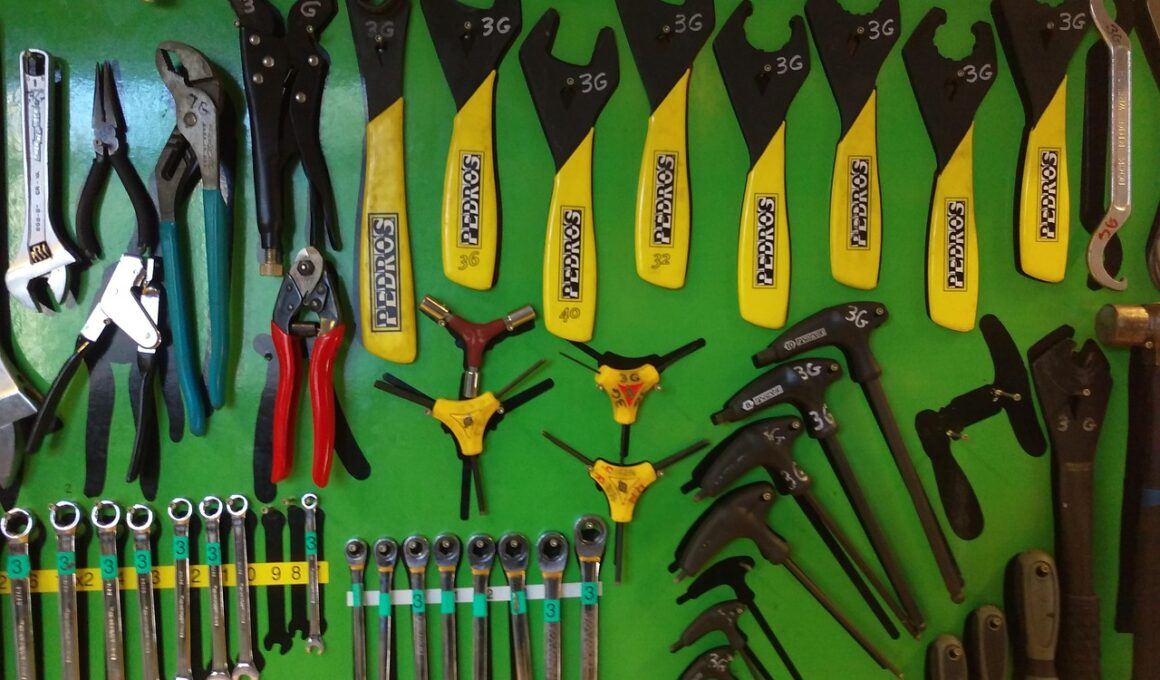Repairing Common Bike Problems While Touring
When embarking on a bike touring adventure, it’s crucial to be prepared for potential bike issues that can arise. The most prevalent problem cyclists face is a flat tire, often due to sharp objects on the road or faulty tire seals. To fix a flat, start by removing the wheel and inspecting the tube for punctures. If the damage is small, a puncture repair kit will often suffice to patch it, ensuring you’re back on the road quickly. Always carry a spare tube and a portable pump or CO2 inflator to minimize downtime. Having these essentials on hand allows you to be self-sufficient during your travels. Furthermore, regularly checking tire pressure before long rides is essential to prevent flats. To keep your tires in the best condition, inspect them for wear and replace them before you begin your tour. By addressing tire issues early, you can enhance your cycling experience and avoid complications later. Being aware of these common issues and having the necessary tools will ensure you’re well-prepared for anything the road throws at you. Additionally, learning basic repairs will boost your confidence as a cyclist on the journey.
Another frequent concern for touring cyclists is chain maintenance. A noisy or stiff bike chain can lead to inefficient pedaling and increased wear on your bike’s components. To maintain optimal chain function, regularly clean and lubricate it. Use a degreaser to remove dirt and old lubricant, followed by applying a suitable bike chain lubricant. Wipe off any excess lubricant as this can attract dirt, compromising the chain’s performance. Check for wear and stretching at periodic intervals using a chain checker tool to determine whether it needs replacing. A worn chain can lead to poor shifting and ultimately damage other components such as the cassette and chainrings. It is wise to carry a spare chain link, a quick-link tool, or a chain breaker on your journey. Practicing these maintenance habits will not only prolong the life of your bike’s components but also enhance your cycling performance. Furthermore, educating yourself about proper chain care techniques and having necessary tools like a multi-tool can empower you to solve issues as they arise, keeping you on your planned route without significant delays.
Brake Issues on Your Touring Bike
Brake problems are another concern that may arise during long-distance cycling tours. It’s vital to ensure that your brakes are functioning optimally, as they are critical for your safety. There are two common types of braking systems: rim brakes and disc brakes. Rim brakes may suffer from wear on the brake pads or misalignment, while disc brakes could have issues with the rotor alignment or caliper adjustment. Both should be inspected regularly to ensure proper function. If your rim brakes squeak or feel less responsive, it may be time to adjust the brake pads or replace them. For disc brakes, check for rotor wear or contaminants; cleaning the rotor with isopropyl alcohol might resolve minor issues. Carrying a small multi-tool can help in making necessary adjustments on the road. Knowing how to bypass brake problems can mean the difference between a smooth ride and a potentially dangerous situation. Furthermore, planning for brake maintenance, such as cleaning brake pads and rotors, before your journey can instill peace of mind during your tour.
Gear shifting issues can also cause disruptions while bike touring and can be a result of cable tension problems or misalignment of derailleurs. It’s essential for cyclists to familiarize themselves with their bike’s shifting mechanism to effectively troubleshoot issues on the road. To handle minor adjustments, carrying a small toolkit, including a screwdriver and an Allen key set, can be incredibly beneficial. If your bike is not shifting smoothly, check the derailleur alignment and cable tensions. Quick adjustments to the cable can often solve shifting problems, allowing for seamless transitions between gears. Also, regular cleaning and lubrication of the derailleur mechanism can prevent buildup that complicates shifting. Know the sound and feel of your bike in good working conditions; this will help you recognize when something is wrong. Taking the time to diagnose and fix these shifting troubles can enhance your riding experience, especially during demanding terrains common in touring routes. It’s also prudent to practice these adjustments at home before departure, giving you the confidence to tackle any issues while on the road.
Lighting and Electrical Concerns
When cycling at dawn, dusk, or in low-light conditions, having a reliable lighting system is essential for safety. Problems with your lights can go unnoticed until needed, so regular checks are necessary. Ensure that your front and rear lights are operational before you embark on your tour. If you rely on battery-operated lights, bring extra batteries or consider using rechargeable lights for reliability. Alternatively, some cyclists opt for dynamos to generate power while riding. Addressing lighting issues can prevent dangerous situations and improve visibility to drivers and pedestrians alike. If your lights flicker or fail to operate altogether, inspect wires for damage or loose connections. Knowing how to replace dead bulbs or fuses is a valuable skill for any touring cyclist. In addition, consider using reflective gear or stickers to enhance your visibility. Being proactive with lighting issues and familiarizing yourself with electrical systems will provide safety advantages during your travels. Ensuring you have adequate lighting can reduce anxiety as you journey down less-trafficked roads and navigate challenging terrains during your tour.
Another bike aspect to monitor on tours is your saddle and handlebar comfort. Extended hours on the saddle can lead to discomfort or pain. Therefore, ensuring you have an appropriate saddle is essential for your overall enjoyment of the ride. Invest time in choosing a saddle that aligns with your riding style and body shape. Consider testing saddles during shorter rides before committing to a long tour to find the right one for you. Additionally, handlebar height and angle should be adjusted to enhance comfort and reduce strain on your back and wrists. Carrying a small toolkit can help modify handlebar settings when required. When discomfort arises, take break stops to stretch and relieve tension. Spending time finding the right settings for your tour can enhance your overall experience and help you enjoy the journey without pain. Moreover, consider additional accessories like ergonomic grips or padded shorts to support comfort over long distances. Familiarizing yourself with saddle and handlebar adjustments will prepare you for ensuring an enjoyable touring experience.
Conclusion
In conclusion, being prepared for common bike issues is crucial for any cyclist planning a touring adventure. By understanding potential problems like flat tires, chain maintenance, brake adjustments, and gear shifting issues, you can better equip yourself for unforeseen circumstances. Carrying essential tools and replacement parts ensures you can handle issues efficiently. Preparing ahead through regular maintenance and repairs is key to a successful journey. Your comfort while riding, such as finding the right saddle and adjusting handlebars, also plays a critical role in your overall experience. Prioritize lighting systems and reflectivity for visibility and safety. With basic mechanical skills and a toolkit, you can confidently tackle challenges that arise on the road. Moreover, the experience you gain from fixing issues empowers you as a cyclist. Embracing these skills not only enhances your trips but also fosters a sense of adventure. By planning and preparing properly, you can overcome obstacles and ensure that your cycling tours remain enjoyable and fulfilling while exploring new landscapes. Adventure awaits when you ride prepared!



